“We’ve dabbled in Lean concepts but we’re not totally embedded with Lean,” says Doug Fozo, Schafer Gear’s quality manager. “Lean isn’t something where you just say, ‘We’re all Lean.’ Lean is perpetual, always changing, so we’re always trying to change with it. But we use a lot of Lean concepts; we’re going more and more towards smaller batches, less inventory, etc.”
Whatever a company’s approach, and whatever they call it, company-wide continuous improvement is the bottom line.
“It’s survival in the business world, in my opinion,” says Fozo. “You’ve got to continue to satisfy your customers, and to satisfy your customers you’ve got to have the systems in place to do it and improve it. You’ve got to have the systems in place to be checking and verifying your parts throughout the process, and ensure before they go out the door that they meet the customer’s requirements.”
Gear companies attempting to hit the always-moving-target that is customer expectations are implementing other measures as well. At Boston Gear, Prosser points to robust, in-house, twice-weekly audits of its 43 machining cells. The auditors’ 10-point inspection documents print specs, bore size, gage calibration, routing and print revisions, and more, including proper finished part storage.
“I think it’s important that whenever you do auditing that you stay as close to the process as possible,” says Prosser. “I feel this is a very, very important audit that we do. We used to audit more after a finished operation, but of course then it is too late to do anything about it.”
Added to that is yet another pre-emptive quality check, recently implemented at Boston Gear.
“We’ve gotten a fair amount of internal auditors certified now,” says Prosser. “So we’re taking a step up from that and starting an ISO coordinators program. We take a member from each department and make them ISO coordinators, and some of the things they’ll be involved in are internal and external (ISO) audits. They’ll look at their documents and records to ensure that they’re being reviewed and are up to date.”
 Quality plastic is not an oxymoron. If all of the above seems challenging, the same applies for injection molded, plastic gear manufacturers. Rod Kleiss, president of Kleiss Gears in Grantsburg, WI, explains how making molded gears is similar yet different from metal gear manufacture.
Quality plastic is not an oxymoron. If all of the above seems challenging, the same applies for injection molded, plastic gear manufacturers. Rod Kleiss, president of Kleiss Gears in Grantsburg, WI, explains how making molded gears is similar yet different from metal gear manufacture.
“In plastics, we have another huge step or hurdle before getting to final product,” says Kleiss. “We make a cavity, and we make it with all of the accuracy and precision that a person would make the metal gear with, but that will not be the shape of our final gear. Our final gear will shrink away from that—change, distort—and what we’re after is a big step away from there. Somehow we have to target a shape and make another shape that’s different in order to get what we want.”
Kleiss, too, is a Lean practitioner, especially regarding labor costs and human error.

The clean-as-a-whistle shop floor at Kleiss Gears.
“Lean to my mind implies automation, and I can’t afford to have a person go in and do a job that can be done by a machine. Primarily because the machine is going to do it more repeatedly and more accurately than a person. And if you have things set up so that a machine can always do it, that means you must have a pretty stable process. And so whenever I see someone opening a door to a molding machine or doing some manual operation, I know we have an issue that has to be dealt with. Repetitive work deadens the mind, dulls the senses, and you’re going to see more errors. And the fact that they’re doing the work is going to cause more errors.”
Another challenge for molded gear makers is longer lead times specific to injection molding, necessitated by the often complex development of precision molds. Given the prevailing “I-want-it-yesterday” mindset of today’s customer, that’s a problem with no magic bullet fix.
“The customer is always looking for proper fit and function of the final product,” says Kleiss. “Quite often they don’t know what they must have in (plastic) gears to achieve those goals. Additionally, there isn’t a lot of history for plastic molded gears concerning questions of noise, wear, or load. Even materials are poorly researched for gear applications, or at least poorly reported in the industry. To a large extent, the customer must rely on the molder to answer gear design, material, and inspection questions correctly.”
As for lead times, says Kleiss, “Delivery is a tough nut to crack. We are also challenged to provide even quicker prototypes. We have tried SLA (stereolithography) with some success for some applications.” Kleiss mentions other things the company is doing to speed along the process, such as what he calls a lead time-shortening “gear-on-a-stick” molding tool that allows for quicker change outs for cavities and core pins. But the reality that remains, according to Kleiss, is that “In today’s world, it is rare to be given more than 10 weeks to produce final product. Quite often the desire is for half that time. Five years ago, we could take 10 to 12 weeks for tooling and on-time was virtually 100%. We are still close to 100% on-time, but tooling has gone down to six to eight weeks for most jobs.”
Capabilities upgrades have quality consequences. Of course, the traditional gear companies discussed in this
article have their own unique production quality issues—grinding, for example. It’s become a major element of finished gear products over the past 10 years or so, as applications have become both more sophisticated and demanding in terms of noise, load, and other issues. Today’s reality is that high-precision gears are also expected to meet specifications involving cosmetics, MSDS constraints and functionality.
At Schafer Gear (and Boston Gear), where most grinding is done in-house, those demands have led in turn to proactive improvements in the grinding department’s quality procedures.
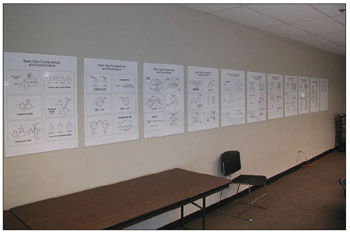
Schafer Gear’s training room, with wall-mounted instructional panels. In-house, on-the-job training is a necessity for today’s gear manufacturers.
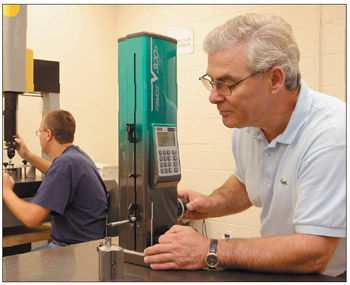
Precipart’s QC inspector Mihai Burucea (foreground) working at a digital height-gaging machine, while Ken Gentry monitors a CMM machine.
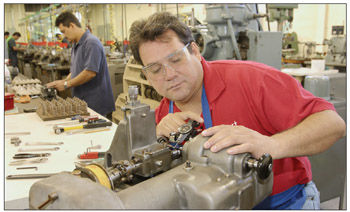
Jose Talavera (foreground), gear manager, and operator Julio Reyes in Precipart’s gear department.
“The biggest (quality) upgrade has been in the gear grinding, and it’s causing us to look at a lot of our internal quality system because everything got upped a notch,” says Schafer’s Fozo. “The quality of the finished gears, the quality of the lead, the profile; everything that we do was kicked up a notch. The market demanded it, and that’s why we went in that direction.”
Boston Gear, as we’ve already seen, addresses the quality issues attached to grinding by its comprehensive use of in-house auditors.
But as mentioned earlier, robust quality standards must be company-wide in today’s market. And so gear companies like Schafer, Boston, Precipart and Kleiss are also looking—quoting Mr. Shakespeare—“with a lean and hungry look” at streamlining their packing and shipping departments.
“By putting in a designated storage location and stockage level for shipping supplies, we have not run out of packaging,” says Robert Doshi, Schafer’s production manager. “We have standardized the work instructions on all work orders to ensure the quality and consistency of our packaging.” Doshi adds that they’ve also reorganized the shipping department to “facilitate the flow of materials into and out of ” that area. One result, according to Doshi, has been the ability to ship more same-day priority parts. Another is a drop in past due deliveries by 75%.
At Precipart, a job shop where small quantities of specialty precision parts are the rule, grinding is not done in-house, but by a nearby, trusted supplier. Precipart’s Rudolf, however, admits that “It is becoming more of a problem for us because you have no control over delivery times.” Which is one reason Lean practices are so important there. Purchasing is one of many departments where Lean can help tremendously.
“If you have 12 weeks to do a job and you burn three weeks (in Purchasing) getting material, getting work orders together, you’ve just lost three weeks,” says Rudolf. “So that process has to be looked at and streamlined with Lean principles.”
But Rudolf harbors no illusions over where the competitive edge exists these days.
“Right now the main customer expectation is lead time because I don’t see quality or price being an issue anymore, meaning that if your price or quality aren’t there there’s nothing to talk about. So now you hear, ‘This guy can give it to me in 10 weeks but I want it in eight.’ There’s tremendous pressure in the industry with lead time because no one wants to keep inventory anymore. So it has to flow.”
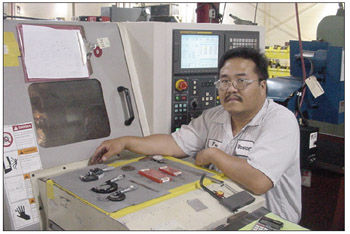
Fue Thauo of Boston Gear at his lathe.

The quality lab at Schafer Gear. Carts with project-specific parts staged for transport to the production area can be seen at lower left.
Rudolf says that Precipart—as do many other companies—relies on detailed value stream mapping to track every job sequence on its journey from Purchasing to Shipping. He adds that, at Precipart, lead time improvement is tracked on a “client and/or project” basis, pointing to a value stream-mapped project for a customer in which lead time was reduced by four weeks.
At Boston Gear, improvements in the shipping department have been kaizen-intensive, leading to various Lean tools integration.
For instance, says Prosser, “One project was to match pick location with product popularity. After performing numerous time studies, we were able to determine the inventory locations with the easiest—and quickest—pick times. We then defined our products into three categories—‘A’ items are frequently picked; ‘B’ items are seldom picked; and ‘C’ items are rarely picked. We then moved our ‘A’ items to the most desirable locations in the warehouse, based on picking speed and ease of picking.” And so forth. Another kaizen-inspired upgrade was a “visual picking board,” which allows supervisors to track in real time the workload of each on-shift picker. That information is then used to assign picking orders to those handlers with the available time and opportunity relative to an order’s priority. It’s a classic application of Lean principles.
And on it goes. Gear shops everywhere continue to explore any means possible to get leaner and faster, to continually improve, and to keep their customers coming back for more. In truth, companies no longer have much choice in the matter.
“If you’re not continuously improving, I don’t know how a company can survive, I really don’t,” says Fozo. “Even if you are a ‘Ma and Pa’ shop, you still face the pressure of outside competition. And if you’re not doing anything to better yourself or improve, I don’t know how you can survive in today’s global economy. Somebody’s always going to be out there trying to beat you.”
For more information:
Boston Gear Company
14 Hayward Street
Quincy, MA 02171
Phone: (617) 328-3300
Fax: (617) 479-6238
Internet: www.bostongear.com
Kleiss Gears Inc.
390 Industrial Drive
Grantsburg, WI 54840
Phone: (715) 463-5995
Fax: (715) 463-5996
Website: www.kleissgears.com
E-mail: rodkleiss@kleissgears.com
Precipart Corp.
90 Finn Court
Farmingdale, NY 11735
Phone: (631) 694-3100
Fax: (631) 694-4016
Internet: www.precipart.com
Schafer Gear Works
4701 Nimtz Parkway
South Bend, IN 46628-6151
Phone: (574) 234-4116
Fax: (574) 234-4115
Internet: www.schafergear.com
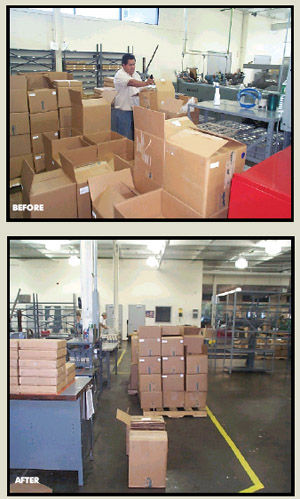








 Quality plastic is not an oxymoron. If all of the above seems challenging, the same applies for injection molded, plastic gear manufacturers. Rod Kleiss, president of Kleiss Gears in Grantsburg, WI, explains how making molded gears is similar yet different from metal gear manufacture.
Quality plastic is not an oxymoron. If all of the above seems challenging, the same applies for injection molded, plastic gear manufacturers. Rod Kleiss, president of Kleiss Gears in Grantsburg, WI, explains how making molded gears is similar yet different from metal gear manufacture.






